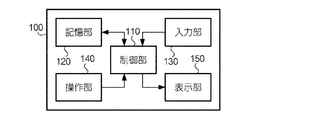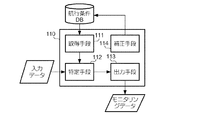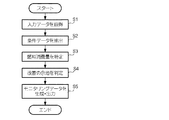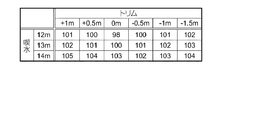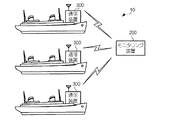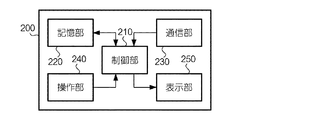JP5890540B2 - Ship management apparatus and program - Google Patents
Ship management apparatus and program Download PDFInfo
- Publication number
- JP5890540B2 JP5890540B2 JP2015001533A JP2015001533A JP5890540B2 JP 5890540 B2 JP5890540 B2 JP 5890540B2 JP 2015001533 A JP2015001533 A JP 2015001533A JP 2015001533 A JP2015001533 A JP 2015001533A JP 5890540 B2 JP5890540 B2 JP 5890540B2
- Authority
- JP
- Japan
- Prior art keywords
- ship
- navigation
- trim
- data
- fuel consumption
- Prior art date
- Legal status (The legal status is an assumption and is not a legal conclusion. Google has not performed a legal analysis and makes no representation as to the accuracy of the status listed.)
- Active
Links
- 239000000446 fuel Substances 0.000 claims description 68
- 230000006872 improvement Effects 0.000 claims description 9
- 238000004364 calculation method Methods 0.000 claims description 5
- 238000012806 monitoring device Methods 0.000 description 26
- 238000010586 diagram Methods 0.000 description 18
- 238000004891 communication Methods 0.000 description 16
- 238000012544 monitoring process Methods 0.000 description 16
- 238000007726 management method Methods 0.000 description 14
- 238000012986 modification Methods 0.000 description 10
- 230000004048 modification Effects 0.000 description 10
- 238000000034 method Methods 0.000 description 8
- 238000012937 correction Methods 0.000 description 5
- 238000005259 measurement Methods 0.000 description 5
- 230000008569 process Effects 0.000 description 4
- 230000006870 function Effects 0.000 description 3
- 238000012545 processing Methods 0.000 description 3
- XLYOFNOQVPJJNP-UHFFFAOYSA-N water Substances O XLYOFNOQVPJJNP-UHFFFAOYSA-N 0.000 description 3
- 230000008859 change Effects 0.000 description 2
- 238000012360 testing method Methods 0.000 description 2
- IYLGZMTXKJYONK-ACLXAEORSA-N (12s,15r)-15-hydroxy-11,16-dioxo-15,20-dihydrosenecionan-12-yl acetate Chemical compound O1C(=O)[C@](CC)(O)C[C@@H](C)[C@](C)(OC(C)=O)C(=O)OCC2=CCN3[C@H]2[C@H]1CC3 IYLGZMTXKJYONK-ACLXAEORSA-N 0.000 description 1
- 238000004458 analytical method Methods 0.000 description 1
- 230000008901 benefit Effects 0.000 description 1
- 239000000284 extract Substances 0.000 description 1
- 239000004973 liquid crystal related substance Substances 0.000 description 1
- 230000003287 optical effect Effects 0.000 description 1
- 230000008520 organization Effects 0.000 description 1
- 230000009467 reduction Effects 0.000 description 1
- IYLGZMTXKJYONK-UHFFFAOYSA-N ruwenine Natural products O1C(=O)C(CC)(O)CC(C)C(C)(OC(C)=O)C(=O)OCC2=CCN3C2C1CC3 IYLGZMTXKJYONK-UHFFFAOYSA-N 0.000 description 1
- 230000001960 triggered effect Effects 0.000 description 1
- 238000012800 visualization Methods 0.000 description 1
Images
Description
本発明は、効率的な航行を支援するための技術に関する。 The present invention relates to a technique for supporting efficient navigation.
船舶の燃料消費は、船舶の姿勢(喫水、トリム等)の影響を受ける。したがって、船舶の姿勢を適切にすることで、船舶の燃料消費量の削減が期待できる。特許文献1には、船舶の排水量やトリムを種々変化させた水槽試験から得たデータに基づくデータベースを参照し、実船のトリムが最適になるようにバラストタンクへの注排水量を演算する航海システムが記載されている。
The fuel consumption of a ship is affected by the attitude of the ship (draft, trim, etc.). Therefore, the fuel consumption of the ship can be expected to be reduced by making the attitude of the ship appropriate.
一方、本発明は、船舶が所定の航行条件で航行した場合よりも高い航行性能を発揮できる航行条件を特定できるようにすることを目的とする。 On the other hand, an object of the present invention is to make it possible to specify navigation conditions that can exhibit higher navigation performance than when a ship navigates under predetermined navigation conditions.
本発明は、一の態様において、トリム、船速、喫水の組み合わせによって規定される航行条件に対応付けて燃料消費量を記憶した記憶手段と、船舶の航行中において前記航行条件を取得する取得手段と、該取得された航行条件に含まれるトリムの理想値からのずれに基づいて決定される燃料消費量の改善率と、前記船舶の残航の距離とに基づいて、トリムの調整の要否の判定に必要な情報を算出する算出手段と、該算出された情報を出力する出力手段とを備える船舶管理装置を提供する。In one aspect, the present invention provides storage means for storing fuel consumption in association with navigation conditions defined by a combination of trim, boat speed, and draft, and acquisition means for acquiring the navigation conditions during navigation of the ship. And the necessity of trim adjustment based on the improvement rate of the fuel consumption determined based on the deviation of the trim from the ideal value included in the acquired navigation conditions and the distance of the remaining sailing of the ship A ship management apparatus is provided that includes a calculation unit that calculates information necessary for the determination, and an output unit that outputs the calculated information.
好ましい態様において、前記情報は、トリムの調整の有無で前記残航において消費されると見込まれる燃料の量の差分によって表される。In a preferred embodiment, the information is represented by a difference in the amount of fuel that is expected to be consumed in the remaining flight with or without trim adjustment.
好ましい態様において、前記情報は、前記トリムの調整の必要性の度合いを表す情報を生成する。In a preferred aspect, the information generates information indicating a degree of necessity of the trim adjustment.
好ましい態様において、前記算出手段は、前記残航において予測される気象条件を更に用いて、前記情報を算出する。In a preferred aspect, the calculation means calculates the information by further using a weather condition predicted in the remaining flight.
本発明は、他の観点において、トリム、船速、喫水の組み合わせによって規定される航行条件に対応付けて燃料消費量を記憶した記憶手段を有するコンピュータに、船舶の航行中において前記航行条件を取得するステップと、該取得された航行条件に含まれるトリムの理想値からのずれに基づいて決定される燃料消費量の改善率と、前記船舶の残航の距離とに基づいて、トリムの調整の要否の判定に必要な情報を算出するステップと、該算出された情報を出力するステップとIn another aspect, the present invention provides a computer having storage means for storing fuel consumption in association with navigation conditions defined by a combination of trim, boat speed, and draft, and acquiring the navigation conditions during navigation of the ship. The trim adjustment based on the step of adjusting the fuel consumption rate determined based on the deviation of the trim from the ideal value included in the acquired navigation conditions and the distance of the remaining sailing of the ship. Calculating information necessary for determining necessity, and outputting the calculated information;
を実行させるためのプログラムを提供する。Provide a program to execute.
本発明によれば、船舶が所定の航行条件で航行した場合よりも高い航行性能を発揮できる航行条件を特定することができる。 ADVANTAGE OF THE INVENTION According to this invention, the navigation conditions which can exhibit higher navigation performance than the case where a ship navigates on predetermined navigation conditions can be specified.
[第1実施形態]
図1は、本発明の一実施形態であるモニタリング装置100のハードウェア構成を示すブロック図である。モニタリング装置100は、貨物船などの船舶に搭載され、当該船舶が航行するときの状態を使用者(運航者等)に知らせるための装置である。モニタリング装置100は、例えば、一般的なパーソナルコンピュータによって実現可能である。モニタリング装置100は、制御部110と、記憶部120と、入力部130と、操作部140と、表示部150とを備える。
[First Embodiment]
FIG. 1 is a block diagram showing a hardware configuration of a
制御部110は、モニタリング装置100の各部の動作を制御する手段である。制御部110は、CPU(Central Processing Unit)などの演算処理装置やメモリを備え、所定のプログラムを実行することにより、表示部150による表示の制御や当該表示に必要な演算を実行する。
The
記憶部120は、データを記憶する手段である。記憶部120は、ハードディスク、フラッシュメモリなどの記録媒体を備え、制御部110によって用いられるデータを記憶する。例えば、記憶部120は、制御部110により実行されるプログラムや、航行条件DB(database)を記憶することができる。
The
航行条件DBは、船舶の航行に関する条件である航行条件と、当該船舶が当該航行条件で航行したときの燃料消費量とを航行条件毎に記録したデータベースである。この航行条件DBには、モニタリング装置100が搭載されている船舶についてのデータが記録されている。したがって、航行条件DBに記録されるデータは、船舶毎又は船型(すなわち船舶の種類)毎に異なる。航行条件DBに記憶されているデータは、本発明の「第1のデータ」の一例に相当する。
The navigation condition DB is a database that records, for each navigation condition, a navigation condition that is a condition related to the navigation of the ship and a fuel consumption amount when the ship navigates under the navigation condition. In this navigation condition DB, data about a ship on which the
図2は、航行条件DBに記録されたデータのデータ構造を示す図である。同図に示すように、航行条件DBには、「トリム」、「喫水」及び「船速」の3種類の航行条件と、この航行条件で船舶が航行した場合の「燃料消費量」の組み合わせを示すデータが記録されている。すなわち、本実施形態における航行条件は、トリム、喫水及び船速である。ここにおいて、トリムとは、船首喫水と船尾喫水の差をいい、船首喫水が船尾喫水よりも大きい場合(前トリム)に正となり、船尾喫水が船首喫水よりも大きい場合(後トリム)に負となる値である。また、喫水とは、船底から水面までの垂直距離をいい、ここでは、船首喫水と船尾喫水の平均値であるとする。また、船速とは、船舶の速度をいい、ここでは対地速度であるとする(ただし、対水速度であってもよい。)。 FIG. 2 is a diagram illustrating a data structure of data recorded in the navigation condition DB. As shown in the figure, the navigation condition DB includes a combination of three types of navigation conditions of “trim”, “draft” and “ship speed”, and “fuel consumption” when the ship navigates under these navigation conditions. Is recorded. That is, the navigation conditions in this embodiment are trim, draft, and ship speed. Here, the trim refers to the difference between the bow draft and the stern draft, and is positive when the bow draft is larger than the stern draft (front trim), and negative when the stern draft is larger than the bow draft (rear trim). Is the value. The draft is the vertical distance from the bottom of the ship to the surface of the water. Here, it is assumed that the draft is the average value of the draft at the bow and the stern draft. Further, the ship speed refers to the speed of the ship, and here it is assumed to be the ground speed (however, it may be the water speed).
航行条件DBには、さまざまな航行条件における燃料消費量が記録されている。例えば、航行条件DBには、トリムを0.5m刻み、喫水を1m刻み、船速を1ノット刻みでそれぞれ変化させたそれぞれの場合の燃料消費量が記述されている。なお、航行条件DBに記録されているデータは、模型船による水槽試験や過去の航海において実際に計測された値などに基づいて、あらかじめ決められている。以下においては、航行条件DBを構成する個々のデータ、すなわちトリム、喫水、船速及び燃料消費量の組み合わせを示すデータのことを「条件データ」という。また、条件データに含まれる航行条件のことを「第1の航行条件」という。 In the navigation condition DB, fuel consumption under various navigation conditions is recorded. For example, the navigation condition DB describes the fuel consumption in each case where the trim is changed by 0.5 m, the draft is changed by 1 m, and the boat speed is changed by 1 knot. The data recorded in the navigation condition DB is determined in advance based on a tank test using a model ship, values actually measured during past voyages, and the like. Hereinafter, individual data constituting the navigation condition DB, that is, data indicating a combination of trim, draft, ship speed, and fuel consumption is referred to as “condition data”. The navigation conditions included in the condition data are referred to as “first navigation conditions”.
入力部130及び操作部140は、データの入力を受け付ける手段である。入力部130は、船舶に搭載された計測機器と通信するためのインタフェースを備え、接続された計測機器から航行条件を示すデータを取得する。操作部140は、マウス、キーボードなどの入力装置を備え、使用者の操作に応じたデータを制御部110に供給する。
The
表示部150は、情報を表示する手段である。表示部150は、液晶ディスプレイなどの表示装置を備え、制御部110から供給される画像データに応じた情報(文字又は画像)を表示する。なお、表示部150は、音声を再生する手段(スピーカ等)を備え、情報を視覚的にだけでなく聴覚的にも出力してもよい。
The
図3は、制御部110の機能的構成を示すブロック図である。制御部110は、所定のプログラムを実行することにより、同図に示す取得手段111、特定手段112、出力手段113及び補正手段114に相当する機能を実現することができる。換言すれば、制御部110は、当該プログラムを実行することによって、本発明に係る船舶管理装置として機能することができる。
FIG. 3 is a block diagram illustrating a functional configuration of the
取得手段111は、条件データを取得する手段である。取得手段111は、記憶部120に記憶された航行条件DBから条件データを取得する。なお、取得手段111は、航行条件DBに含まれる全ての条件データをまとめて取得する必要はなく、必要な条件データのみを取得すればよい。
The
特定手段112は、船舶が所定の航行条件で航行したときの航行性能を特定する手段である。本実施形態において、特定手段112は、航行中の船舶の航行条件を示すデータを逐次取得し、当該データと取得手段111により取得された条件データとに基づいてそのときどきの燃料消費量を特定する。ここにおいて、燃料消費量は、航行性能を示す指標の一例に相当する。特定手段112は、所定の時間間隔(例えば1分毎)で燃料消費量を特定する。
The
特定手段112は、入力部130又は操作部140を介して航行中の船舶の航行条件を示すデータを取得する。以下においては、このとき取得されるデータのことを「入力データ」という。入力データは、航行条件の実測値である。入力データは、船舶に搭載された計測機器から直接入力されてもよいが、使用者が計測機器等を目視によって確認して入力装置によって入力したものであってもよい。
The specifying
出力手段113は、モニタリングデータを出力する手段である。ここにおいて、モニタリングデータとは、航行中の船舶の航行条件と当該船舶の燃料消費に関する情報とを文字又は画像の情報として示すデータをいう。本実施形態において、出力手段113は、モニタリングデータを画像データとして出力し、表示部150に供給する。モニタリングデータは、本発明の「第2のデータ」の一例に相当する。
The
補正手段114は、航行条件DBに含まれる条件データを補正する手段である。補正手段114は、条件データを実測値に基づいて補正する。補正手段114は、条件データが示す航行条件と燃料消費量の関係が実際の関係と異なる場合に、条件データを必要に応じて補正する。なお、補正後の条件データの値は、制御部110によって算出されてもよいし、使用者が入力装置によって入力してもよい。
The correction unit 114 is a unit that corrects the condition data included in the navigation condition DB. The correcting unit 114 corrects the condition data based on the actual measurement value. The correction unit 114 corrects the condition data as necessary when the relationship between the navigation conditions indicated by the condition data and the fuel consumption is different from the actual relationship. Note that the value of the corrected condition data may be calculated by the
モニタリング装置100の構成は、以上のとおりである。この構成のもと、モニタリング装置100は、船舶の航行中にトリム、喫水、船速といった航行条件を示す入力データを逐次取得し、これを条件データと比較することにより使用者に各種の情報を提供する。本実施形態において、モニタリング装置100は、入力データによって与えられる船速及び喫水で航行した場合において燃料消費量が最小となるトリムを特定することにより、燃料消費量の節約(すなわち削減)に資する情報を使用者に提供することができる。すなわち、本実施形態において、モニタリング装置100は、船速及び喫水を不変とし、これらを一定とする条件下において燃料消費量が最小となるトリムを特定する。以下においては、この場合における船速や喫水のように、第1の航行条件のうちの不変とする航行条件のことを「基本条件」という。また、この場合におけるトリムのように、特定対象とする航行条件(すなわち第1の航行条件のうちの可変とする航行条件)のことを「可変条件」という。
The configuration of the
図4は、モニタリング装置100の制御部110が実行する処理を示すフローチャートである。制御部110は、入力データの取得(ステップS1)を契機に図4に示す処理を実行する。すなわち、制御部110は、入力データを取得する毎に図4に示す処理を実行し、表示部150による表示を逐次更新する。
FIG. 4 is a flowchart illustrating processing executed by the
入力データを取得したら、制御部110は、必要な条件データを抽出する(ステップS2)。ステップS2において、制御部110は、ステップS1において取得した入力データが示す船速を参照し、船速が入力データと一致する条件データを記憶部120から読み出して取得する。
When the input data is acquired, the
図5は、ステップS2において抽出される条件データの一例を示す図である。ここでは、船速20ノットの場合の喫水及びトリムと単位距離(例えば1マイル)当たりの燃料消費量の関係を示している。なお、ここにおいて、燃料消費量は、説明の便宜上、喫水13m、トリム0mの場合を「100」と正規化し、これと比較した場合の値として示されている。ただし、実際の条件データは、燃料消費量として実際の燃料の重量(又は容量)が記述されていてもよいし、燃料消費量を示す値(すなわち燃料消費量に換算可能な値)として船舶の所要馬力(例えば船舶の主機関の所要馬力、エンジン出力)が記述されていてもよい。また、記憶部120は、図2に示した構造の条件データに代えて、図5のように船速が同一であるデータ群をテーブルとし、このようなテーブルを船速毎に保持してもよい。
FIG. 5 is a diagram illustrating an example of the condition data extracted in step S2. Here, the relationship between the draft and trim at a boat speed of 20 knots and the fuel consumption per unit distance (for example, 1 mile) is shown. Here, for convenience of explanation, the fuel consumption is shown as a value when the draft of 13 m and the trim of 0 m is normalized to “100” and compared with this. However, in the actual condition data, the actual fuel weight (or capacity) may be described as the fuel consumption, and the value of the fuel consumption (ie, the value that can be converted into the fuel consumption) Required horsepower (for example, required horsepower of the main engine of the ship, engine output) may be described. Further, the
次に、制御部110は、ステップS1、S2において得られたデータを用いて、その時点の航行条件での燃料消費量を特定する(ステップS3)。制御部110は、入力データが示す航行条件に一致する航行条件を示す条件データを特定することによって、当該航行条件に対応する燃料消費量を特定することができる。なお、条件データに基づく特定は推定であるため、実際の燃料消費量とは必ずしも一致しない。
Next, the
燃料消費量を特定したら、制御部110は、燃料消費量の改善の余地を判定する(ステップS4)。具体的には、制御部110は、条件データを用いて、基本条件(本実施形態においては、船速及び喫水、すなわちトリム以外)を同一とした場合の燃料消費量の最小値を特定し、当該最小値とステップS3において特定した燃料消費量の差分を求める。制御部110は、このようにして求めた差分の大小に基づいて燃料消費量の改善の余地を判定する。制御部110による具体的な判定方法は、特に限定されず、例えば、所要馬力の差によって判定してもよいし、残航(すなわち距離)を考慮に入れてもよい。
After specifying the fuel consumption, the
その後、制御部110は、ステップS3、S4の処理に基づいてモニタリングデータを生成及び出力し、表示部150に供給する(ステップS5)。すなわち、制御部110は、表示部150にモニタリングの結果を表示させる。なお、このとき制御部110は、警告音や合成音声を再生させるためのデータを生成してもよい。例えば、制御部110は、ステップS4の判定結果に基づき、「現在、トリムは良好です」といった合成音声を再生させてもよい。
Then, the
図6は、表示部150に表示される情報を例示する図である。ここでは、図5に示した条件データを用いたと仮定し、船舶の実際のトリムが「+1m」であった場合と「0m」であった場合とをそれぞれ例示している。なお、いずれの場合においても、喫水は13m、船速は20ノットであったとする。また、この例(及び後述する第2実施形態の例)においては、判定結果として、燃料消費量の改善の余地が1%未満の場合には「A」、1%以上2%未満の場合には「B」、2%以上5%未満の場合には「C」、5%以上の場合には「D」という記号を用いることとする。
FIG. 6 is a diagram illustrating information displayed on the
この例において、燃料消費量が最小となるトリムの値は、図5に示すように、「0m」である。ここで、船舶の実際のトリムが「+1m」であった場合、燃料消費量としては2%の改善の余地がある。なぜならば、トリムが「0m」である場合の燃料消費量を「100」としたとき、トリムが「+1m」である場合の燃料消費量が「102」、すなわち2%増だからである。したがって、船舶の実際のトリムが「+1m」であった場合、制御部110による判定結果は「C」である。なお、トリムの欄に記載された船体を模した画像は、船舶のトリムの状態を視覚化したものであり、右側が船首で左側が船尾である。
In this example, the trim value that minimizes the fuel consumption is “0 m” as shown in FIG. Here, when the actual trim of the ship is “+1 m”, there is room for improvement of 2% in terms of fuel consumption. This is because when the fuel consumption when the trim is “0 m” is “100”, the fuel consumption when the trim is “+1 m” is “102”, that is, an increase of 2%. Therefore, when the actual trim of the ship is “+1 m”, the determination result by the
また、この例において、残航(300マイル)に対して予定されている燃料消費量が250トンであるとする。そうすると、トリムが「+1m」である場合において、船舶が同じ航行条件のまま残航を航行したとすると、トリムを最適(すなわち0m)にした場合と比べて5トン(250トン×2%)の燃料を余分に消費することになる。よって、トリムが「+1m」である場合には、燃料の節減の余地が5トン分あることになる。制御部110は、入力データと条件データを用いてこのような計算を実行し、トリムの調整による燃料消費量の改善の余地や燃料の節減の余地を使用者に報知することが可能である。なお、ここでいう最適なトリムとは、燃料消費量を最小にすることができるトリムのことである。
In this example, it is assumed that the fuel consumption scheduled for the remaining flight (300 miles) is 250 tons. Then, if the trim is “+ 1m” and the ship sails with the same sailing conditions, it is 5 tons (250 tons x 2%) compared to the optimal trim (ie, 0 m). It will consume extra fuel. Therefore, when the trim is “+1 m”, there is 5 tons of room for fuel saving. The
さらに、制御部110は、判定結果に応じて情報の表示態様を異ならせてもよい。例えば、制御部110は、判定結果が「A」である場合の文字等の表示色とそうでない場合の表示色とを異ならせたり、判定結果が比較的良好でない場合(すなわち燃料消費量の改善の余地が比較的多い場合)には文字等を点滅表示させたりするように画像データを生成及び出力してもよい。
Furthermore, the
なお、図5には図示されていないが、制御部110は、必要に応じて条件データを補正してもよい。例えば、制御部110は、補正を実行する旨の操作を使用者が行った場合や、あらかじめ決められたタイミングで、条件データを補正することができる、制御部110は、航行条件の実測値(すなわち入力データ)と燃料消費量の実測値とを用いて燃料消費量の誤差を判断し、その誤差が所定の範囲を超える条件データがあった場合に、誤差が少なくなるように条件データを補正する。
Although not shown in FIG. 5, the
以上のとおり、モニタリング装置100によれば、そのときどきの基本条件(船速及び喫水)に応じた最適な可変条件(トリム)を報知することにより、現状の航行条件で航行した場合よりも少ない燃料消費量で航行できる可能性があることを使用者に知らせることが可能である。使用者は、モニタリング装置100の出力を参照することによって、船舶を最適なトリムで航行させることができるようになる。ただし、船舶は、気象、海象、船舶の構造などのさまざまな要因により、必ずしも常に最適なトリムで航行することができるとは限らない。したがって、使用者は、実際にはモニタリング装置100の出力を参考にしながら、そのときどきの状況に適した航行条件で船舶を運航させる。
As described above, according to the
[第2実施形態]
図7は、本発明の別の実施形態である船舶管理システム10の全体構成を示す図である。船舶管理システム10は、海上を航行中の複数の船舶に搭載された通信装置300と、複数の通信装置300と無線通信により通信するモニタリング装置200とを備える構成である。本実施形態において、モニタリング装置200は、船上ではなく陸地において使用される。すなわち、モニタリング装置200の使用者は、複数の船舶の運航を統括的に監視する者であり、この点において第1実施形態の使用者と相違する。
[Second Embodiment]
FIG. 7 is a diagram showing an overall configuration of a
なお、本実施形態において、上述した第1実施形態と同一の名称で説明される構成要素やデータは、第1実施形態において説明されたものと同一又は類似のものであるとする。本実施形態においては、第1実施形態と同一の名称の構成要素又はデータについては、重複する説明を適宜省略し、主に第1実施形態との相違点について説明することとする。 In the present embodiment, the components and data described with the same names as those in the first embodiment are the same as or similar to those described in the first embodiment. In the present embodiment, the overlapping description will be omitted as appropriate for the components or data having the same names as those in the first embodiment, and differences from the first embodiment will be mainly described.
通信装置300は、搭載された船舶において得られる入力データを送信する装置である。通信装置300は、通信衛星を介した無線通信、すなわち衛星通信によって、入力データをモニタリング装置200に送信する。通信装置300は、船舶に搭載された計測機器に接続され、当該計測機器から入力データの供給を受ける構成であってもよいし、船上の(モニタリング装置200の使用者とは別の)使用者によって入力データが手入力される構成であってもよい。なお、通信装置300は、入力データを送信するだけでなく、必要に応じてモニタリング装置200からデータを受信してもよい。本実施形態の入力データは、本発明の「第3のデータ」の一例に相当する。
The
図8は、モニタリング装置200のハードウェア構成を示すブロック図である。モニタリング装置200は、入力部130に代えて通信部230を備えるほかは、第1実施形態のモニタリング装置200と同様の構成である。通信部230は、通信装置300との間でデータを送受信する手段である。
FIG. 8 is a block diagram illustrating a hardware configuration of the
なお、本実施形態の記憶部220は、航行条件DBに複数の船舶についての条件データを記憶しており、この点において第1実施形態の記憶部120と相違する。ただし、航行条件と燃料消費量の関係が実質的に同一になる船舶があれば、その船舶については条件データが共用されてもよい。例えば、船型が同一の船舶などがこれに該当し得る。
In addition, the memory |
船舶管理システム10の構成は、以上のとおりである。船舶管理システム10においては、この構成のもと、複数の船舶からの入力データがモニタリング装置200に集められる。モニタリング装置200は、複数の船舶のそれぞれについて、それぞれの船舶に応じた条件データに基づき、第1実施形態のモニタリング装置100と同様の判定を個別に実行し、判定結果に応じた情報を表示する。
The configuration of the
図9は、表示部250に表示される情報を例示する図である。このように、モニタリング装置200は、複数の船舶についての判定結果や航行条件などを表示する。使用者は、必要に応じて、通信装置300と通信を行い、トリムの調整などの指示を行うことができる。
FIG. 9 is a diagram illustrating information displayed on the
[変形例]
本発明は、上述した実施形態に限定されず、以下の変形例のような他の形態でも実施可能である。また、以下に示す変形例は、必要に応じて、各々を適宜に組み合わせて実施することも可能である。
[Modification]
The present invention is not limited to the above-described embodiments, and can be implemented in other forms such as the following modifications. Moreover, the modification shown below can also be implemented combining each suitably as needed.
(変形例1)
本発明において、航行条件とは、船舶の航行時において航行性能に影響を与え得る諸条件をいう。ここにおいて、航行性能とは、与えられた航行条件下で船舶が発揮し得る性能のことをいい、燃料消費量のほかに、船速、馬力(エンジン出力)、燃費などによっても特定可能である。よって、条件データ(第1のデータ)は、航行条件と燃料消費量とを対応付けたものに限らず、航行条件と船速、馬力、燃費などとを対応付けたものであってもよい。例えば、ある船速で航行するために必要となる馬力は、トリムなどの可変条件に応じて変わり得る。この場合、船速は基本条件に該当し、馬力は航行性能に該当する。同様に、基本条件をプロペラの回転数とし、航行性能を船速や馬力としてもよい。なお、航行性能がより高い状態とは、船速においてはより高速な状態のことであり、馬力においてはより低馬力な状態のことであり、燃費においてはより低燃費な状態のことである。
(Modification 1)
In the present invention, the navigation condition refers to various conditions that can affect the navigation performance during navigation of the ship. Here, navigation performance refers to the performance that a ship can exhibit under given navigation conditions, and can be specified by ship speed, horsepower (engine output), fuel consumption, etc. in addition to fuel consumption. . Therefore, the condition data (first data) is not limited to the navigation condition and the fuel consumption associated with each other, but the navigation condition may be associated with the ship speed, horsepower, fuel consumption, and the like. For example, the horsepower required for navigating at a certain ship speed can vary depending on variable conditions such as trim. In this case, the ship speed corresponds to the basic condition, and the horsepower corresponds to the navigation performance. Similarly, the basic condition may be the rotation speed of the propeller, and the navigation performance may be the ship speed or horsepower. The state where the navigation performance is higher is a state where the boat speed is higher, the horsepower is a state where the horsepower is lower, and the fuel efficiency is a state where the fuel efficiency is lower.
ただし、航行性能の指標として用いる値は、条件データが示す基本条件とは重複しない必要がある。なぜならば、本発明において基本条件とは、不変とする航行条件のことであり、固定値であることが前提であるからである。例えば、船速を航行性能として用いる場合にあっては、船速は基本条件には含まれ得ず基本条件からは除外される必要がある。 However, the value used as an indicator of navigation performance must not overlap with the basic conditions indicated by the condition data. This is because the basic condition in the present invention is a navigation condition that does not change, and is assumed to be a fixed value. For example, when the ship speed is used as the navigation performance, the ship speed cannot be included in the basic condition and needs to be excluded from the basic condition.
また、航行条件は、トリム、喫水及び船速のみに限定されず、また、これらの全てが必須でもない。例えば、気象、海象、船体汚れなども、本発明に係る航行条件の一例に該当し得る。ここにおいて、気象とは、天候、風力(又は風速)、風向などであり、海象とは、海流、潮流、波高などである。また、船体汚れとは、例えば船体への付着物(海洋生物など)であり、船体が汚れているほど燃料消費量が増加する傾向にある。船体汚れは、例えば、使用者が目視によってこれを確認し、その程度を所定の段階で数値化することで航行条件に用いることが可能である。 Further, the navigation conditions are not limited to trim, draft and ship speed, and all of these are not essential. For example, weather, sea conditions, ship hulls, and the like can also correspond to examples of navigation conditions according to the present invention. Here, the weather is weather, wind power (or wind speed), wind direction, and the like, and the sea state is ocean current, tidal current, wave height, and the like. Further, hull dirt is, for example, deposits (marine life, etc.) on the hull, and the fuel consumption tends to increase as the hull gets dirty. The hull dirt can be used as a navigation condition by, for example, a user confirming this visually and quantifying the degree at a predetermined stage.
図10は、条件データのデータ構造の他の例を示す図である。同図に示す条件データは、航行条件に「風力」と「波高」を含む点において、図2に示した条件データと相違する。ここにおいて、風力とは、所定の指標(例えば、ビューフォート風力階級)によって示される。このような条件データを用いると、航行条件がより少ない(図2のような)場合に比べ、航行性能を特定する精度を向上させることが可能である。 FIG. 10 is a diagram illustrating another example of the data structure of the condition data. The condition data shown in the figure is different from the condition data shown in FIG. 2 in that the navigation conditions include “wind force” and “wave height”. Here, the wind force is indicated by a predetermined index (for example, Beaufort wind class). By using such condition data, it is possible to improve the accuracy of specifying the navigation performance as compared with the case where the navigation conditions are smaller (as shown in FIG. 2).
また、図11は、条件データのデータ構造の他の例を示す図である。同図に示す条件データは、航行性能として主機の所要馬力を用いた場合の例であり、これを等値線によって示したもの(すなわちコンター図)である。また、ここにおいて、航行条件は、「船速」、「トリム(横軸)」及び「喫水(縦軸)」であり、船速を基本条件としている。 FIG. 11 is a diagram illustrating another example of the data structure of the condition data. The condition data shown in the figure is an example when the required horsepower of the main engine is used as the navigation performance, and this is indicated by an isoline (that is, a contour diagram). Here, the navigation conditions are “ship speed”, “trim (horizontal axis)” and “draft (vertical axis)”, and the ship speed is a basic condition.
図11の例においては、トリム及び喫水の双方が大である領域(具体的には、図中の左下側)には、馬力の値が存在しない。この領域は、船舶がこのような航行条件をとり得ないことを示している。このような領域は、例えば、喫水が浅く、かつ前トリムになった結果プロペラが露出してしまい、船舶が現実的には航行できない状態となる領域である。このような(現実的にはとり得ない)航行性能の値をあらかじめ除外することで、現実的でないモニタリングデータが出力されないようにすることが可能である。 In the example of FIG. 11, there is no horsepower value in a region where both trim and draft are large (specifically, the lower left side in the figure). This area indicates that the ship cannot take such navigation conditions. Such a region is, for example, a region where the draft is shallow and the propeller is exposed as a result of the front trim, and the ship cannot actually travel. It is possible to prevent unrealistic monitoring data from being output by excluding such navigation performance values (which are practically impossible).
(変形例2)
上述した実施形態において、トリムは、船舶の傾きを表す指標の一例である。本発明において、船舶の傾きは、トリム(すなわち、船首喫水と船尾喫水の差)以外のものによって特定されてもよい。例えば、いわゆる傾斜計のような計測機器を船舶に設置することによって、船首喫水及び船尾喫水を直接読み取ることなく船舶の傾きを特定することも可能である。
(Modification 2)
In the embodiment described above, the trim is an example of an index that represents the inclination of the ship. In the present invention, the inclination of the ship may be specified by something other than trim (that is, the difference between the bow draft and the stern draft). For example, by installing a measuring instrument such as a so-called inclinometer on the ship, it is possible to specify the inclination of the ship without directly reading the bow draft and stern draft.
また、本発明は、船舶の前後方向(すなわち進行方向)の傾きに代えて、又はこれとともに、船舶の左右方向(すなわち進行方向と直交する方向)の傾きを航行条件に含んでもよい。したがって、本発明は、トリムを最適化するだけでなく、ヒールをも最適化するものであってもよい。 Further, the present invention may include, in the navigation condition, an inclination in the left-right direction of the ship (that is, a direction orthogonal to the traveling direction) instead of or in addition to the inclination in the front-rear direction (that is, the traveling direction) of the ship. Thus, the present invention may not only optimize trim but also optimize heel.
(変形例3)
本発明は、航海中の航行条件のモニタリングだけではなく、航海前の予測や、航海終了後の分析にも用いることができる。したがって、本発明における入力データ(換言すれば、所定の航行条件を示すデータ)は、必ずしも実測値でなくてもよい。例えば、本発明は、船舶の運航計画を立てる場合に、どのような航行条件で航行するとどの程度の燃料消費量になるのかを予測するために用いることも可能である。このような場合には、入力データとして予測値が用いられる。また、気象や海象を航行条件に含む場合には、予定されている航路における予報値を入力データとして用いればよい。気象又は海象の予報値は、これを提供する公共又は民間の機関から提供を受ければよい。
(Modification 3)
The present invention can be used not only for monitoring navigation conditions during voyage but also for prediction before voyage and analysis after voyage is completed. Therefore, the input data (in other words, data indicating a predetermined navigation condition) in the present invention does not necessarily have to be an actually measured value. For example, the present invention can also be used to predict how much fuel consumption will be achieved under what navigation conditions when making a ship operation plan. In such a case, a predicted value is used as input data. Further, when weather conditions and sea conditions are included in the navigation conditions, a forecast value in a planned route may be used as input data. The forecast value of the weather or sea condition may be provided from a public or private organization that provides it.
(変形例4)
本発明は、出力手段により出力されるデータ(第2のデータ、モニタリングデータ)を表示の用に供するだけでなく、船舶の制御などの他の用途に用いてもよい。例えば、本発明は、特定手段により特定された燃料消費量よりも少ない燃料消費量で航行可能なトリムの値が存在する場合に、そのようなトリムになるようにバラストポンプを制御するものであってもよい。
(Modification 4)
The present invention may be used not only for displaying data (second data, monitoring data) output by the output means but also for other uses such as ship control. For example, the present invention controls a ballast pump so as to achieve such a trim when there is a trim value that can be navigated with a fuel consumption smaller than the fuel consumption specified by the specifying means. May be.
(変形例5)
本発明において、航行条件を報知する方法は、図6や図9のような表示に限定されない。例えば、モニタリング装置100は、判定結果が比較的良好でない場合(例えば「C」又は「D」)にのみ警告を表示する一方、判定結果が比較的良好な場合(例えば「A」又は「B」)には特に情報を表示しないようにしてもよい。あるいは、このような警告を行う場合であれば、表示部150による表示に代えて警告音を発するだけであってもよい。この場合の警告音は、実際のトリムが最適地よりも大きい場合と小さい場合とで異なる音としてもよい。すなわち、モニタリング装置100による報知は、そのときの実際の航行条件よりも燃料消費量を少なくすることができる航行条件が存在することを使用者に近くさせることができるものであれば、その具体的な手法を問わない。
(Modification 5)
In the present invention, the method for notifying the navigation conditions is not limited to the display as shown in FIGS. For example, the
(変形例6)
本発明は、トリム(すなわち船舶の傾き)以外の航行条件の調整を行うためのものであってもよく、例えば喫水を調整するためのものであってもよい。例えば、図5に示した航行条件において、喫水を「13m」に限定しなければ、燃料消費量が最も少なくなるのは喫水を「12m」、トリムを「0m」にした場合である。なお、船舶の場合、船速を低下させることによっても燃料消費量を少なくすることが可能であるが、船速を低下させると目的地までの所要時間が多くなる。
(Modification 6)
The present invention may be for adjusting the navigation conditions other than trim (ie, the inclination of the ship), for example, for adjusting the draft. For example, if the draft is not limited to “13 m” in the navigation conditions shown in FIG. 5, the fuel consumption is the smallest when the draft is “12 m” and the trim is “0 m”. In the case of a ship, it is possible to reduce fuel consumption by reducing the ship speed. However, if the ship speed is reduced, the time required to reach the destination increases.
(変形例7)
本発明は、船舶管理装置やこれを備えた船舶管理システムとしてだけではなく、船舶管理装置を用いた船舶管理方法、コンピュータを本発明の船舶管理装置として機能させるためのプログラムなどとして特定されてもよい。さらに、本発明に係るプログラムは、光ディスクなどの記録媒体に記録した形態や、インターネットなどのネットワークを介して、コンピュータにダウンロードさせ、これをインストールして利用可能にする形態などでも提供することができる。また、本発明に係る船舶管理装置は、例えば、特定手段と出力手段とが別の装置によって実現される、といったように、複数の動作主体によって構成されてもよい。
(Modification 7)
The present invention is not limited to a ship management apparatus or a ship management system including the same, but may be specified as a ship management method using the ship management apparatus, a program for causing a computer to function as the ship management apparatus of the present invention, and the like. Good. Furthermore, the program according to the present invention can be provided in a form recorded on a recording medium such as an optical disc, or a form that is downloaded to a computer via a network such as the Internet, and can be installed and used. . Moreover, the ship management apparatus according to the present invention may be configured by a plurality of operating entities such that, for example, the specifying unit and the output unit are realized by different devices.
10…船舶管理システム、100、200…モニタリング装置、110、210…制御部、111…取得手段、112…特定手段、113…出力手段、114…補正手段、120、220…記憶部、130…入力部、140、240…操作部、150、250…表示部、230…通信部、300…通信装置
DESCRIPTION OF
Claims (5)
船舶の航行中において前記航行条件を取得する取得手段と、Acquisition means for acquiring the navigation conditions during navigation of the ship;
該取得された航行条件に含まれるトリムの理想値からのずれに基づいて決定される燃料消費量の改善率と、前記船舶の残航の距離とに基づいて、トリムの調整の要否の判定に必要な情報を算出する算出手段と、Judgment of necessity of trim adjustment based on the improvement rate of the fuel consumption determined based on the deviation from the ideal trim value included in the acquired navigation conditions and the distance of the remaining sailing of the ship Calculating means for calculating information necessary for
該算出された情報を出力する出力手段とOutput means for outputting the calculated information;
を備える船舶管理装置。A ship management apparatus comprising:
ことを特徴とする請求項1に記載の船舶管理装置。The ship management apparatus according to claim 1.
ことを特徴とする請求項1に記載の船舶管理装置。The ship management apparatus according to claim 1.
ことを特徴とする請求項1ないし3のいずれか一つに記載の船舶管理装置。The ship management apparatus according to any one of claims 1 to 3, wherein
船舶の航行中において前記航行条件を取得するステップと、Obtaining the navigation conditions during navigation of the ship;
該取得された航行条件に含まれるトリムの理想値からのずれに基づいて決定される燃料消費量の改善率と、前記船舶の残航の距離とに基づいて、トリムの調整の要否の判定に必要な情報を算出するステップと、Judgment of necessity of trim adjustment based on the improvement rate of the fuel consumption determined based on the deviation from the ideal trim value included in the acquired navigation conditions and the distance of the remaining sailing of the ship Calculating the information required for
該算出された情報を出力するステップとOutputting the calculated information;
を実行させるためのプログラム。A program for running
Priority Applications (1)
| Application Number | Priority Date | Filing Date | Title |
|---|---|---|---|
| JP2015001533A JP5890540B2 (en) | 2015-01-07 | 2015-01-07 | Ship management apparatus and program |
Applications Claiming Priority (1)
| Application Number | Priority Date | Filing Date | Title |
|---|---|---|---|
| JP2015001533A JP5890540B2 (en) | 2015-01-07 | 2015-01-07 | Ship management apparatus and program |
Related Parent Applications (1)
| Application Number | Title | Priority Date | Filing Date |
|---|---|---|---|
| JP2014508211A Division JPWO2014188584A1 (en) | 2013-05-24 | 2013-05-24 | Ship management device, ship management system and program |
Publications (3)
| Publication Number | Publication Date |
|---|---|
| JP2015083468A JP2015083468A (en) | 2015-04-30 |
| JP2015083468A5 JP2015083468A5 (en) | 2015-12-10 |
| JP5890540B2 true JP5890540B2 (en) | 2016-03-22 |
Family
ID=53047331
Family Applications (1)
| Application Number | Title | Priority Date | Filing Date |
|---|---|---|---|
| JP2015001533A Active JP5890540B2 (en) | 2015-01-07 | 2015-01-07 | Ship management apparatus and program |
Country Status (1)
| Country | Link |
|---|---|
| JP (1) | JP5890540B2 (en) |
Families Citing this family (2)
| Publication number | Priority date | Publication date | Assignee | Title |
|---|---|---|---|---|
| JP6921560B2 (en) * | 2017-03-02 | 2021-08-18 | ナブテスコ株式会社 | Information processing equipment and programs |
| CN110097631B (en) * | 2019-04-08 | 2023-01-13 | 中国长江电力股份有限公司 | Upward-scanning ship three-dimensional model construction method |
Family Cites Families (4)
| Publication number | Priority date | Publication date | Assignee | Title |
|---|---|---|---|---|
| JP4275442B2 (en) * | 2003-03-31 | 2009-06-10 | ヤマハ発動機株式会社 | Attitude angle control device, attitude angle control method, attitude angle control device control program, and cruise control device |
| JP5173989B2 (en) * | 2009-11-12 | 2013-04-03 | 三菱重工業株式会社 | Sailing trim automatic change system |
| JP5312425B2 (en) * | 2010-10-18 | 2013-10-09 | ジャパンマリンユナイテッド株式会社 | Ship operation support system |
| JP5174940B2 (en) * | 2011-07-05 | 2013-04-03 | Jfe物流株式会社 | Ship operation support device |
-
2015
- 2015-01-07 JP JP2015001533A patent/JP5890540B2/en active Active
Also Published As
| Publication number | Publication date |
|---|---|
| JP2015083468A (en) | 2015-04-30 |
Similar Documents
| Publication | Publication Date | Title |
|---|---|---|
| WO2014188584A1 (en) | Ship managing device, ship managing system, and program | |
| CN110967022B (en) | Ship navigational speed optimization auxiliary decision-making system | |
| JP5328874B2 (en) | Navigation support equipment and ships | |
| JP5312425B2 (en) | Ship operation support system | |
| US8761975B2 (en) | Method and apparatus for real-time polars | |
| JP5191263B2 (en) | Ship navigational state analyzer | |
| US10000262B2 (en) | Data-processing device, program, recording medium and data-processing method for generation of data that indicates navigation performance of ship | |
| KR101661928B1 (en) | Ship Energy Management Method and System | |
| JP2013134089A (en) | Optimal sailing route calculating apparatus and optimal sailing route calculating method | |
| JP5543037B1 (en) | Navigation analysis device, navigation analysis method, program, and recording medium | |
| JP5890540B2 (en) | Ship management apparatus and program | |
| US10293899B2 (en) | Device, program and recording medium for supporting analysis of fuel consumption in voyage of ship | |
| JP7342515B2 (en) | Estimation method, learning method, estimation program, and estimation device | |
| JP5433117B1 (en) | Ship allocation device, ship allocation method, program, and recording medium | |
| JP7171599B2 (en) | Ship management device, ship, ship management system, and ship management method | |
| KR102052814B1 (en) | Information processing apparatus and program | |
| JP7189764B2 (en) | Ship performance estimation device and ship performance estimation program | |
| JP2007050759A (en) | Hydrographic chart information processing method, its information system, its information program, and recording medium | |
| JP5699246B1 (en) | Ship allocation support device, ship allocation support method, program, and recording medium | |
| EP3901579B1 (en) | Navigation assistance method, navigation assistance device, and navigation assistance program | |
| JP6165697B2 (en) | Ship speed calculation device and ship speed calculation method | |
| US20240027193A1 (en) | Dynamic easyrouting utilizing onboard sensors | |
| EP4342786A2 (en) | Information processing apparatus and vessel | |
| EP3002206B1 (en) | Improved vessel maneuverability | |
| JP2011086196A (en) | Image display apparatus, image display method and image display program |
Legal Events
| Date | Code | Title | Description |
|---|---|---|---|
| A521 | Request for written amendment filed |
Free format text: JAPANESE INTERMEDIATE CODE: A523 Effective date: 20151022 |
|
| A621 | Written request for application examination |
Free format text: JAPANESE INTERMEDIATE CODE: A621 Effective date: 20151022 |
|
| A871 | Explanation of circumstances concerning accelerated examination |
Free format text: JAPANESE INTERMEDIATE CODE: A871 Effective date: 20151022 |
|
| A975 | Report on accelerated examination |
Free format text: JAPANESE INTERMEDIATE CODE: A971005 Effective date: 20151124 |
|
| TRDD | Decision of grant or rejection written | ||
| A01 | Written decision to grant a patent or to grant a registration (utility model) |
Free format text: JAPANESE INTERMEDIATE CODE: A01 Effective date: 20160202 |
|
| A61 | First payment of annual fees (during grant procedure) |
Free format text: JAPANESE INTERMEDIATE CODE: A61 Effective date: 20160218 |
|
| R150 | Certificate of patent or registration of utility model |
Ref document number: 5890540 Country of ref document: JP Free format text: JAPANESE INTERMEDIATE CODE: R150 |
|
| R250 | Receipt of annual fees |
Free format text: JAPANESE INTERMEDIATE CODE: R250 |
|
| R250 | Receipt of annual fees |
Free format text: JAPANESE INTERMEDIATE CODE: R250 |
|
| R250 | Receipt of annual fees |
Free format text: JAPANESE INTERMEDIATE CODE: R250 |
|
| R250 | Receipt of annual fees |
Free format text: JAPANESE INTERMEDIATE CODE: R250 |
|
| R250 | Receipt of annual fees |
Free format text: JAPANESE INTERMEDIATE CODE: R250 |
|
| R250 | Receipt of annual fees |
Free format text: JAPANESE INTERMEDIATE CODE: R250 |
